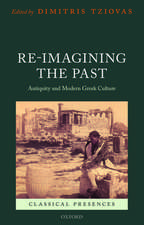Rome, Ostia, Pompeii: Movement and Space
Editat de Ray Laurence, David J. Newsomeen Limba Engleză Paperback – 26 apr 2018
| Toate formatele și edițiile | Preț | Express |
|---|---|---|
| Paperback (1) | 238.28 lei 31-37 zile | |
| OUP OXFORD – 26 apr 2018 | 238.28 lei 31-37 zile | |
| Hardback (1) | 708.29 lei 10-16 zile | |
| OUP OXFORD – 24 noi 2011 | 708.29 lei 10-16 zile |
Preț: 238.28 lei
Nou
Puncte Express: 357
Preț estimativ în valută:
45.60€ • 49.52$ • 38.30£
45.60€ • 49.52$ • 38.30£
Carte tipărită la comandă
Livrare economică 12-18 aprilie
Preluare comenzi: 021 569.72.76
Specificații
ISBN-13: 9780198707004
ISBN-10: 0198707002
Pagini: 468
Dimensiuni: 158 x 235 x 24 mm
Greutate: 0.83 kg
Editura: OUP OXFORD
Colecția OUP Oxford
Locul publicării:Oxford, United Kingdom
ISBN-10: 0198707002
Pagini: 468
Dimensiuni: 158 x 235 x 24 mm
Greutate: 0.83 kg
Editura: OUP OXFORD
Colecția OUP Oxford
Locul publicării:Oxford, United Kingdom
Recenzii
This widely divergent collection of papers, contributed by an interdisciplinary group of scholars, is highly specialised although, as all the Latin quotations are translated, also accessible to academics in such fields as Cultural Studies, Town Planning, Urban Geography and Sociology, from which it derives much of its specialist terminology. But it does reward persistence with a very vivid vision of the teeming streets of ancient Roman towns.
The editors and contributors are to be commended for pointing us in a new direction and restoring movement to our reconstructions of Rome.
. . . will be of interest not only to students of the past but even to todays town planners . . . opening a new historiography
This is a very rich volume that scholars will want to read in its entirety.
This highly detailed and absorbing study crosses academic disciplines, is, as one would expect from its editors, thoroughly researched with an extensive bibliography, and is peppered with entertaining gems
Each chapter has something to recommend it . . . this is a beautifully produced book that moves its reader onto and through the streets of the Roman city.
[the essays] maintain a high level of theoretical analysis and show thorough knowledge of both literary and archaeological sources . . . A special feature is the bibliography, covering no fewer than 40 pages, and constituting a guide to the best work in Roman archaeology and social history in the last 100 years. A work of advanced scholarship for advanced scholars.
The evidence, theories, and methodologies used by the contributors provide a synthesis demonstrating how further study of movement in the Roman world can aid in explaining cultural, social, political and economic change.
in presenting a broad collection of scholarship explicitly focused on movement, the editors have reinvigorated future research on space and movement and have proven its interdisciplinary applicability . . . an ambitious and innovative collection of stimulating scholarship that is certain to have a considerable impact on the future of spatial studies and will clearly form a core text for both scholars and students of Roman urbanism for many years to come.
The editors and contributors are to be commended for pointing us in a new direction and restoring movement to our reconstructions of Rome.
. . . will be of interest not only to students of the past but even to todays town planners . . . opening a new historiography
This is a very rich volume that scholars will want to read in its entirety.
This highly detailed and absorbing study crosses academic disciplines, is, as one would expect from its editors, thoroughly researched with an extensive bibliography, and is peppered with entertaining gems
Each chapter has something to recommend it . . . this is a beautifully produced book that moves its reader onto and through the streets of the Roman city.
[the essays] maintain a high level of theoretical analysis and show thorough knowledge of both literary and archaeological sources . . . A special feature is the bibliography, covering no fewer than 40 pages, and constituting a guide to the best work in Roman archaeology and social history in the last 100 years. A work of advanced scholarship for advanced scholars.
The evidence, theories, and methodologies used by the contributors provide a synthesis demonstrating how further study of movement in the Roman world can aid in explaining cultural, social, political and economic change.
in presenting a broad collection of scholarship explicitly focused on movement, the editors have reinvigorated future research on space and movement and have proven its interdisciplinary applicability . . . an ambitious and innovative collection of stimulating scholarship that is certain to have a considerable impact on the future of spatial studies and will clearly form a core text for both scholars and students of Roman urbanism for many years to come.
Notă biografică
Ray Laurence is Professor of Ancient History at Macquarie University. In 2006 he won the 'Longman-History Today New Generation Prize for book most likely to inspire the young to study history' for his volume Pompeii The Living City.David J. Newsome was awarded his PhD in 2010 from the University of Birmingham. He won the BABESCH-Byvanck Award in 2008 for his innovative research on traffic and urban change at Pompeii. Both have published widely on the Roman city.

















